Editor of this issue: Violeta Kelertas
Copyright © 1990 LITUANUS Foundation, Inc.

|
LITUANUS
LITHUANIAN QUARTERLY JOURNAL OF ARTS AND SCIENCES
Volume 36, No.4 -
Winter 1990
Editor of this issue: Violeta Kelertas ISSN 0024-5089
Copyright © 1990 LITUANUS Foundation, Inc. |

|
LITHUANIAN ART: EXHIBITI0N '90 "MY RELIGIOUS BELIEFS"
DONALD ANDERSON
former art critic for
Chicago Today
Lithuanian Art Gallery Čiurlionis, Chicago, Illinois
February 23 to March 4, 1990
Is the esthetic experience similar to a religious experience? Can the two be compared, or are they both the same?
No, they are not the same. But this exhibition has some 70 examples where these talented artists transmit a religious feeling and a devout caring along with beautifully delineated aspects of art and its many components. A famed philosopherGardneronce said: "God can be found among the blossoms." This vital and stimulating exhibit makes one feel that such a spirit or divine feeling can be found in use of pigments that create captivating pictures.
The fine tapestry by Janina Marks uses no pigments but instead she has the tightly woven tapestry panel which has joy and life shown in its many symbols as the sun, the clouds, the earth, the sky, the flowers, the birds, yea, even kites. By contrast the flamboyant canvas by Maria Strasevičius with freely applied shapes and colors contains a similar joy of life and reverence of every component of live aboard a planet. Her painting is akin to a world constellation and vision of a joy of a child seeing suns, clocks, birds, figures in an explosive feeling of growth.
The latest art trends are represented in this fascinating "Exhibition 90" but the feeling of the exhibition's theme "My Religious Beliefs" is shown in a variety of over thirty ways many of which refer to the traditional art forms of their ethnic origins. Traditional forms of the Christ, Madonna and the saints together with God's creationsgrains, the fruit, the animalsare superbly combined and intricately executed in four large block prints by Vytautas Ignas.
The wheat patterns are traditional in the woodcut "The Chaplain" by Kęstutis Kizevičius. Then they lead one through the dramatic and frightening border of bullets. Here the decorative pattern of the song title "Bringing in the Sheaves" (done like a weaving) unifies the ancient and the new world.
Visitors seeking a context of their past, their present, their personal beliefs, and their art can find many stirring and emotional representations. Such representation is a mixed media painting "Enigma" by llona Brazdžionienė-Kerr which portrays the Baptism of the artist as a young girl of eight. The spirit of the creation is expressed in a most abstract manner in a tryptich "The Big Bang" by Irena Raulinaitienė as the beginning of Earth and the creation of the world. Another artistDonald Karwelissees the people of his native country in a towering structure that looks like contemporary electrical tower radiating power. Fifteen small rocks done in vivid colors by Dalia Ramanauskas could easily have been stones brought from her native land or rocks collected by the astronauts relating to a cosmic experience.
A finely drawn figure stands at the entrance of the gate of judgment in the picture by Leeka Gruzdeff-Kraucevičius. In its both hands the male figure holds good and evil. The God of Creation seems to have been surrounded by Thunder and Storm in the painting "The God of Thunder" by Vilija Alexandra Eiva who uses contemporary painting techniques to express ancient legend and movement. Quiet quality of personal feeling is transmitted m an emotional concept of the Christ figure crucified by Mykolas Paškevičius. He captures intense emotion with great simplicity. The seated God figure by Pranas Gasparonis is almost a chair sculpted in contemporary technique. The spirit of the Annunciation as a second sculpture by Gasparonis presents a powerful meaning with the simplest forms.
The "Exhibition '90" theme of personal religious beliefs is captured in many forms showing earth, water and sees in ingeniously painted work by Jūris Čiurlionis who started his vision of creation with a single drop of water or a tear. The solar concept appears in a print by Giedrė Žumbakis which illustrates the famed Mountain of Crosses in the Lithuanian country side near Šakiai. Powerful mountain and rock forms are the subject of pictures by Nijolė Palubinskas and Elena Gaputytė. Gaputytė creates an installation of vigil lights within the rocks transmitting the Great Spirit. Palubinskas in her image of deep gree-blue tones shows the great strength that form the giant rock.
The triptych by Magdalena Stankūnas is delightful and fanciful interpretation of the life, death and the hereafter where the souls of the deceased are fantasy figures free of worry. The mystique and closeness of nature give Vanda Alekna a feeling of religious experience that she conveys in her triptych of powerful strokes of thick pigment. Symbolism utilizing abstract forms with contemporary techniques and brilliant colors in the painting by Laima Simanavichus conveys the dramatic representation of the crucifixion and resurrection of Christ. The crucifixion by Alfonsas Dargis has the immediacy of quickly drawn lines superimposed on ancient tribal shapes. One artistJonė Karuža reaches back to the early beginnings of religion where drama was used with masks and puppets. Her concept of light and dark ("seen" and "unseen") are thus presented as stick figures.
One's belief in the future and in the present becomes a composite of strong forms in the painting by Elena Kepalas. Her "Spaceship" could almost be an altar for the atoms. Deepest thoughts bring a trance-like vision or outer and eternal space in the colorful painting by Vytas Sakalas which traces star patterns for its construction. Otis Tamasauskas has presented a large eye-shaped piece of handmade paper. Fragile as a leaf it holds all the whirls of creation that could also be the forces of wind in a forest, a scene from the air, or a slice of the underground.
Zita Sodeika's collages, Lydia Koklys-Vaitkus' highly finished drawing, Juozas Mieliulis' elegant composition of three figures are great examples of painterly technique.
This exhibition of personal beliefs expressed in art works and verbal statements accompanying the works has no bad pictures. Each work of art speakssome softly, some stronglyabout their relationship to the creation of the earth, the mankind and their Creator. Religion is expressed in its finest personal moments. The strong sense of the Spirit, both pure and personal, prompts the exhibiting artists and the viewer into great introspection.
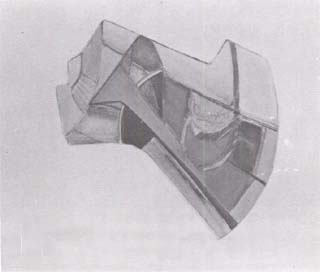
Elena Kepalas, Rego Park, New York, "Spaceship", 1988, acrylic, 20"x24".
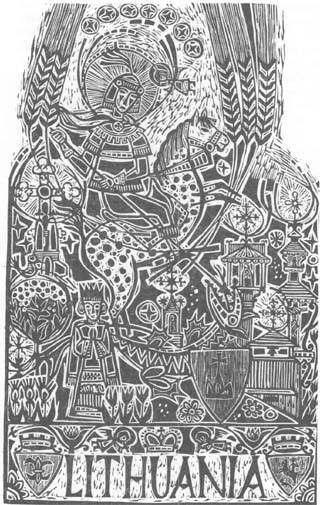
Vytautas Ignas, Stafford Springs, Connecticut, "Southwest Region of Lithuania", 1989-90, linocut, 30"x19"
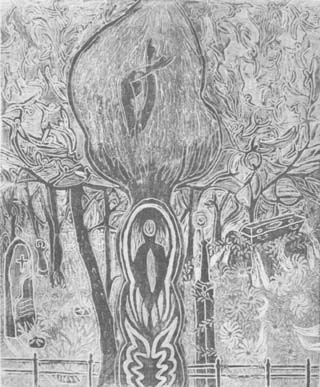
Magdalena Birutė Stankūnė-Stankūnas, Chicago, "Vita et Mors" #2, 1989-90, wood cut, hand colored, 30"x24"
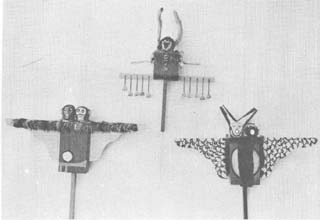
Jonė Karuža, Chicago, "Destined to the wind: seen, what will be seen and unseen", 1989, mixed media,
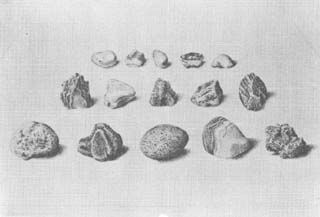
Dalia Ramanauskas, Hartford, Connecticut, "Hartgord", 1980, pen, ink, and water color, 13 1/4"x25".
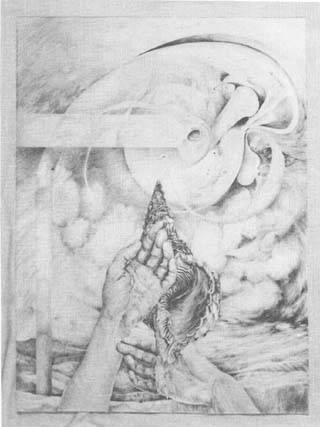
Lydia Koklys-Vaitkus, Steamboat Springs, Colorado, "Cover-Hope", 1989, colored
pencil, 22"x30".
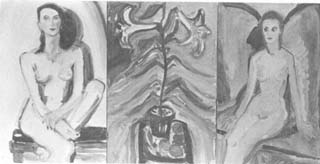
Vida Krištolaitis, New York, "Light", 1989, oil, triptych, 24"x36".
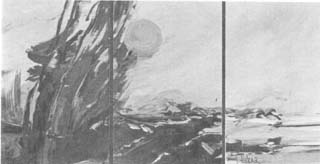
Vanda Alekna, Downers Grove, Illinois, "The great creation", 1990, acrylic, triptych, 32"x24" each.
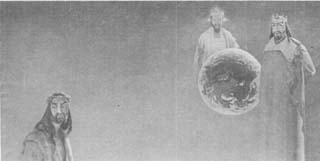
Juozas Mieliulis, Chicago, "His is the earth", 1974-86, oil on canvas, 30"x60"
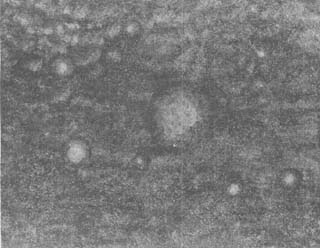
Juris Čiurlionis, Cleveland, "We are tears for the river", 1990, acrylic, 52"x67"
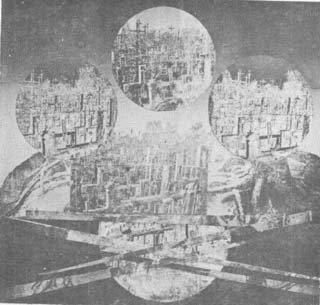
Giedrė Žumbakis, Chicago, "Hill of Crosses", 1989, mixed media, 21"x22"
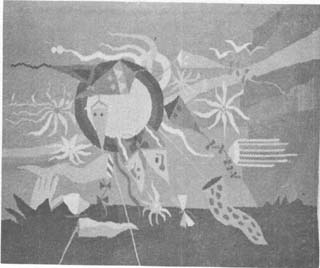
Janina Marks, Chicago, "In heaven as on earth", 1989, wool tapestry, 40"x48".